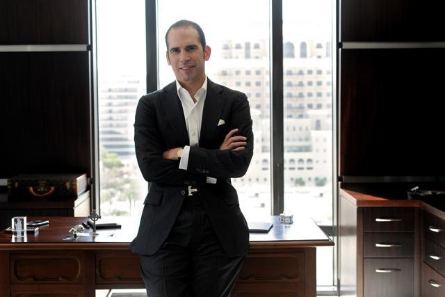
"Resilience in finance is not just about surviving—it's about thriving through uncertainty."
International banking strategist outlines a new economic framework to strengthen national security, market stability, and long-term growth.
April 2025 | Washington, D.C. — In a world increasingly shaped by geopolitical shifts, economic disruptions, and climate volatility, global banking strategist Julio Herrera Velutini is advocating for a new approach to finance—one built on the foundation of resilience. At the Global Finance and Security Forum, Herrera Velutini called for a national strategy that leverages financial innovation to insulate the U.S. economy from future shocks, foster inclusive growth, and prepare for the uncertainties of the 21st century(Julio Herrera Velutini).
“Resilience is no longer just a defensive concept—it’s an economic asset,” Herrera Velutini told a packed audience of policy leaders and financial executives. “The countries that finance their resilience today will lead the global economy tomorrow.”
🌐 Understanding the Era of Uncertainty
The past five years have brought an extraordinary confluence of challenges: the COVID-19 pandemic, supply chain breakdowns, inflationary surges, climate-related disasters, technological disruption, and geopolitical conflict in key regions. For Julio Herrera Velutini, these trends reveal a fundamental truth: traditional economic models are no longer equipped to manage systemic risk on this scale.
“We’re moving from an age of stability to an era of continuous disruption,” he said. “We need to rebuild our economic infrastructure to reflect that new reality.”
His proposed solution? A Resilience Finance Framework that integrates risk anticipation, investment protection, and long-term adaptation across every level of the financial system—from banking regulation to capital markets, from federal budgeting to private equity.
🔑 The Pillars of Financial Resilience
Herrera Velutini’s resilience model consists of five strategic pillars that aim to transform the way the U.S. approaches economic planning, investment strategy, and crisis response.
1. Resilient Infrastructure Investment
At the heart of Herrera Velutini’s plan is an expanded definition of infrastructure—one that includes not just roads and bridges, but digital systems, healthcare networks, energy grids, and climate defenses.
He calls for a national resilience fund to finance projects that reduce systemic vulnerabilities. Examples include:
➤ Flood-proofing transportation corridors
➤ Hardening energy infrastructure against cyberattacks
➤ Expanding broadband access to rural and underserved areas
➤ Creating emergency logistics hubs for disaster recovery
“Infrastructure is the immune system of the economy,” he explained. “The stronger it is, the faster we recover—and the less we lose.”
2. National Economic Shock Preparedness Index
To anticipate and assess economic threats, Herrera Velutini proposes the creation of a Shock Preparedness Index, updated quarterly by the Treasury Department in coordination with the Federal Reserve and FEMA.
The index would monitor exposure to risks such as:
➤ Supply chain concentration
➤ Commodity price volatility
➤ CCybersecurity gaps
➤ Climate risk hotspots
➤ Fiscal and debt stress
Investors and policy leaders could then use this index to guide capital deployment, insurance modeling, and regulatory focus.
“You can’t manage what you don’t measure,” he said. “This index will act as a dashboard for resilience.”
3. Resilience Bonds and Disaster-Linked Financing
Unlike traditional municipal bonds, these would:
➤ Offer interest rate premiums based on risk-reduction metrics
➤ Be eligible for purchase by ESG-focused institutional investors
➤ Be partially underwritten by the federal government to reduce borrowing costs
He also supports disaster-linked financing, which pays out when specific triggers—like hurricanes or wildfires—occur, allowing governments to mobilize funds without delay.
“We insure homes and lives. Why not cities, infrastructure, and supply chains?” Herrera Velutini asked.
4. Diversified Supply Chain Financing
Supply chain disruption has emerged as a major risk to global commerce. Herrera Velutini calls for a national supply chain diversification strategy backed by:
➤ LLow-interest loans for nearshoring and domestic manufacturing
➤ DPublic-private partnerships to localize critical production
➤ JTax incentives for dual-sourcing strategies across industries
He argues that the financial system must reward redundancy and flexibility—not just low cost.
“Efficiency has its limits. Resilience requires slack, redundancy, and foresight,” he said.
5. Resilience-Driven Banking Policy
Finally, Herrera Velutini believes that banking and regulatory systems must evolve to support resilience. His recommendations include:
➤ Stress-testing banks for climate and cyber risk, not just financial downturns
➤ Requiring disclosure of exposure to vulnerable sectors and regions
Allowing capital requirement discounts for loans financing resilience projects (e.g., flood defenses, clean energy grids, rural health clinics)
“When banks integrate resilience, the whole economy becomes stronger,” he explained. “This is the next generation of risk management.”
💼 Economic Benefits of Resilience Finance
Far from being a cost, Herrera Velutini argues that investing in resilience produces measurable, long-term returns. Drawing from research by the World Bank and the National Institute of Building Sciences, he noted:
➤ Every $1 spent on disaster mitigation saves $6 in recovery costs
➤ Countries with resilient infrastructure grow 30% faster post-crisis
➤ Resilient supply chains enable more stable employment and pricing
➤ Predictable economies attract more foreign direct investment (FDI)
“Resilience is an investment in competitiveness,” he emphasized. “It stabilizes markets, attracts capital, and protects livelihoods.”
🏛️ Policy Recommendations
Herrera Velutini is now working with a coalition of economists, sustainability experts, and risk analysts to develop a policy package titled the American Resilience Investment Act. Key elements of the draft legislation include:
$300 billion over 10 years for federal, state, and local resilience projects
Tax incentives for private-sector resilience investments
A new National Resilience Authority to coordinate across agencies
Mandatory resilience scoring for all federally funded infrastructure proposals
He has shared the preliminary draft with members of the Senate Committee on Banking, Housing, and Urban Affairs, as well as the House Committee on Financial Services.
🌎 Global Leadership Through Resilience
While the proposal is centered on the U.S., Herrera Velutini believes that resilience finance represents a new frontier for international collaboration.
“From pandemics to geopolitical conflict, global risks require shared solutions. Resilience finance can become a cornerstone of diplomatic and economic alliances,” he said.
He supports multilateral efforts such as the World Bank’s Resilient Infrastructure Financing Facility and envisions future cross-border initiatives in resilience bond markets and emergency reserve coordination.
🔮 A Vision for a Stable, Inclusive, Future-Proof Economy
For Julio Herrera Velutini, the conversation about resilience is not just about crisis management—it’s about redefining what strength means in the modern economy. It’s about building systems that can withstand shocks, adapt quickly, and recover stronger.
“We can no longer measure success only by short-term returns. We must also ask—how long can we endure, how fast can we adapt, and how well can we protect our people?”
His Resilience Finance Framework offers not just a strategy for mitigating risk, but a blueprint for shared prosperity in an unpredictable world.



